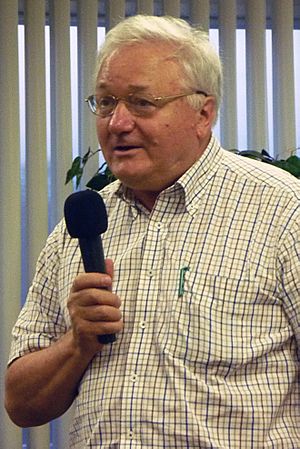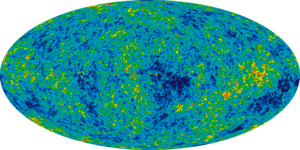Rashid Sunyaev facts for kids
Quick facts for kids
Rashid Sunyaev
|
|
|---|---|

Sunyaev in 2010
|
|
| Born | 1 March 1943 |
| Nationality | Russian, German |
| Alma mater | Moscow Institute of Physics and Technology (MS), Moscow State University (Ph.D) |
| Known for | Cosmic microwave background radiation |
| Awards | King Faisal International Prize for Physics (2009), Heineman Prize (2003), Crafoord Prize (2008), Kyoto Prize (2011), Dirac Medal, ICTP (2019), Max Planck Medal (2023) |
| Scientific career | |
| Fields | Astronomer |
| Institutions | Russian Academy of Sciences, Max Planck Institute for Astrophysics, Institute for Advanced Study |
| Physical cosmology | ||||||||||||||
 |
||||||||||||||
| Universe · Big Bang Age of the universe Timeline of the Big Bang Ultimate fate of the universe
|
||||||||||||||
Rashid Alievich Sunyaev is a famous astrophysicist from Russia and Germany. He was born on March 1, 1943. He is known for his important discoveries about the universe. He studied at the Moscow Institute of Physics and Technology and later became a professor there.
Sunyaev has worked at many top science places. These include the Russian Academy of Sciences and the Max Planck Institute for Astrophysics in Germany. He has also been a visiting professor at the Institute for Advanced Study in Princeton, USA.
Contents
Amazing Discoveries in Space
Rashid Sunyaev has made many big contributions to how we understand space. He often worked with other brilliant scientists.
Understanding the Early Universe
- Predicting Universe's Ripples: With Yakov Zeldovich, Sunyaev helped create a theory about how the early universe grew. They predicted that there would be special patterns, like ripples, in the very first light of the universe. This light is called the Cosmic microwave background radiation (CMB).
- Seeing the Patterns: Later, special space missions like WMAP saw these exact patterns. This showed that their predictions were right! These patterns help scientists understand how galaxies formed.
The Sunyaev-Zeldovich Effect
- Scattering Light: Sunyaev and Yakov Zeldovich also discovered something called the Sunyaev-Zeldovich effect. This happens when light from the CMB travels through huge groups of galaxies called galaxy clusters.
- Hot Gas in Clusters: These galaxy clusters have very hot gas with tiny particles called electrons. When the CMB light hits these electrons, it gets scattered. This changes how the CMB looks when we observe it.
- Studying Galaxy Clusters: Scientists use this effect to find and study galaxy clusters. It helps them learn about how big these clusters are and how they are moving.
Black Holes and X-rays
- Black Hole Disks: Sunyaev and Nikolay I. Shakura created a model to explain how matter falls into black holes. This matter often forms a flat, spinning disk around the black hole, called an accretion disc.
- X-ray Signals: They also figured out that this matter, as it spirals into a black hole, gives off powerful X-rays. These X-rays are like a special signal that tells us a black hole is there.
Space Observatories
- Mir Space Station: Sunyaev led a team that used an X-ray telescope on the Mir space station. In 1987, this telescope made the first discovery of X-rays coming from a supernova. A supernova is a huge explosion of a star.
- GRANAT Observatory: He also worked with the GRANAT orbiting X-ray observatory. This observatory helped scientists study black holes and neutron stars.
- Current Missions: Today, his team is still involved in big space projects. They work with data from the INTEGRAL spacecraft and are preparing for the Spectrum-X-Gamma project. He also helps interpret data from the ESA's Planck spacecraft mission, which studies the CMB.
Awards and Recognitions
Rashid Sunyaev has received many important awards for his work. Here are some of them:
- 1984 – Became a member of the Russian Academy of Sciences.
- 1988 – Won the Bruno Rossi Prize for his work on X-ray sources and black holes.
- 1995 – Received the Gold Medal of the Royal Astronomical Society.
- 2000 – Awarded the Bruce Medal for his amazing research in astronomy.
- 2003 – Won the Dannie Heineman Prize for Astrophysics and the Gruber Prize in Cosmology.
- 2008 – Received the Crafoord Prize for his big contributions to astrophysics and cosmology.
- 2009 – Became a Foreign Member of the Royal Society and won the King Faisal International Prize for Science.
- 2011 – Awarded the Kyoto Prize.
- 2012 – Received the Benjamin Franklin Medal in Physics.
- 2019 – Won the Dirac Medal.
- 2023 – Received the Max Planck Medal.
See also
- Ubaydulla Uvatov
tt:Räşid Sönniev

All content from Kiddle encyclopedia articles (including the article images and facts) can be freely used under Attribution-ShareAlike license, unless stated otherwise. Cite this article:
Rashid Sunyaev Facts for Kids. Kiddle Encyclopedia.
